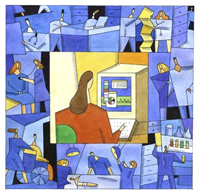
Data Analysis Software
Overview
 "The advantages of computers to nurse researchers are speed, accuracy, and flexibility. Nurse researchers must know how to use the information systems to their advantage to provide them with better information at all phases of data gathering, data analysis, and communication of research findings. This will allow for greater creativity and the development of the body of scientific knowledge upon which nursing theory, practice, and education is based. Nurse researchers and practicing nurses alike must become proficient
in the application and uses of computer technology if they are to hasten the development and use of an empirical base for nursing practice."
- (Hannah, Ball & Edwards, 1994, p. 138).
 Within the last thirty years, the use of computers in nursing research has skyrocketed at a phenomenal rate. One of the most time-saving, and useful applications in research is computerized data analysis. For decades now, serious research has been analyzed using
statistical programs on mainframe computers. This obviously limited the number of professionals, including nurses who had ready access to data analysis tools. With the advent of personal computers powerful enough to run sophisticated statistical software, opportunities for ready research tools have become much more common. Traditional quantitative all-purpose programs such as SPSS and Minitab can now be purchased and utilized on a researcher’s home or office PC. As well, computerized qualitative programs, such as QSR N6 (formerly Nud*ist), NVIVo, and the open source, Weft QDA software have become more well-known and used in studies especially for theme identification and data analysis. The key to finding the right software for an intended study is to pay attention to five software criteria: capabilities, portability, ease of learning and use, reliability and cost (Hannah, Ball & Edwards, 1994). Within the last thirty years, the use of computers in nursing research has skyrocketed at a phenomenal rate. One of the most time-saving, and useful applications in research is computerized data analysis. For decades now, serious research has been analyzed using
statistical programs on mainframe computers. This obviously limited the number of professionals, including nurses who had ready access to data analysis tools. With the advent of personal computers powerful enough to run sophisticated statistical software, opportunities for ready research tools have become much more common. Traditional quantitative all-purpose programs such as SPSS and Minitab can now be purchased and utilized on a researcher’s home or office PC. As well, computerized qualitative programs, such as QSR N6 (formerly Nud*ist), NVIVo, and the open source, Weft QDA software have become more well-known and used in studies especially for theme identification and data analysis. The key to finding the right software for an intended study is to pay attention to five software criteria: capabilities, portability, ease of learning and use, reliability and cost (Hannah, Ball & Edwards, 1994).
In this course you will become very familar with both qualitative and quantitative software and online web-based statistical calculators. You will soon come to appreciate the time-saving, increased reliability, and interpretation enrichment afforded by these convenient and robust analysis technologies.
Ends in View
This learning activity is intended to give the learner the opportunity to:
1. Understand the benefits and limitations of using computerized statistical software in quantitative and qualitative data analysis.
2. Explore the various kinds of statistical software and programs available for use on personal computers for qualitative and quantitative data analysis.
3. Practice performing basic data analysis and graphing functions on a personal computer.
In Preparation
1. BROWSE: Read the Weft QDA Manual and take a tour of the Main website.
2. REVIEW: The Use of Computers in Research Nursing 3220 Handout.
3. EXPLORE: the Demonstration version of “Minitab” Quantitative Data Analysis Software. Practice the online tutorials as well, available at:
https://www.minitab.com/en-us/
4. EXPLORE: the various quantitative statistical java applets on Vassar Stats - Web Site for Statistical Computation. Practice the online tutorials as well, available at:
http://vassarstats.net/
In Practice
1. Practice using the Minitab software to manipulate quantitative data. Compare this to the quantitative functions contained in Excel, Vassar Stats or SPSS programs.
2. Explore the attached Weft QDA manual to become familar with the functions of this free Qualitative data analysis software.
3. Use the applets on the Vassar Statistics site for performing quantitative data analyses such as chi squares, t tests, correlation, and Analysis of Variance.
In Reflection
1. What level of statistical training would be necessary to comfortably use software such as Minitab or Weft QDA?
2. Reflect on the possibilities of human error when using statistical software. How could these be minimized?
References
- Coffey, A., B. Holbrook and P. Atkinson (1996) Qualitative Data Analysis: Technologies and Representations. Sociological Research Online, 1 (1).
- Hannah, K., Ball, M. & Edwards, M. (1994). Introduction to nursing informatics. New York: Springer-Verlag.
- Lau, J., Ioannidis, J.P. & Schmid, C.H. (1997). Quantitative synthesis in systematic reviews. Annals of Internal Medicine, 127, November 1st, p. 820 - 826.
NEXT: CHINS, Telenursing and Societal Health .... . .
|